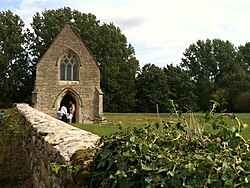Bradwell Abbey: Difference between revisions
m clean up, typos fixed: a urban → an urban |
m →Bradwell Abbey today: ioe -> nhle, replaced: {{IoE|45807 → {{NHLE|1125271 |
||
| Line 27: | Line 27: | ||
The center also hosts school visits to see its mediæval buildings, and how they have changed since then, and its fish ponds and its physic garden. Finally it provides meeting space to local community groups. | The center also hosts school visits to see its mediæval buildings, and how they have changed since then, and its fish ponds and its physic garden. Finally it provides meeting space to local community groups. | ||
The chapel is Grade I listed<ref>{{ | The chapel is Grade I listed<ref>{{NHLE|1125271|Bradwell Abbey Chapel}}</ref> | ||
An annual music festival, Togfest, was started on the site in 1999. | An annual music festival, Togfest, was started on the site in 1999. | ||
Latest revision as of 22:09, 18 September 2019
| Bradwell Abbey | |
|
Buckinghamshire | |
|---|---|
 Chapel at Bradwell Abbey | |
| Location | |
| Grid reference: | SP826395 |
| Location: | 52°2’52"N, -0°47’41"W |
| Order: | Benedictine |
| History | |
| Founded: | 1155 |
| Dissolved: | 1542 |
| Information | |
Bradwell Abbey or Bradwell Priory was a monastery in Buckinghamshire, the site and remains of which are now a Scheduled Ancient Monument. There is also an urban studies site here, and it has given its name to a neighbourhood of Milton Keynes, a town grown around the more ancient establishment
The abbey was founded as a Benedictine priory in 1154 or 1155 and dissolved during the reign of King Henry VIII, almost four centuries later.
Historic Bradwell Priory
The Priory was established around 1154.[1] It grew during the Middle Ages to became an important local centre, but declined during the Black Death when, amongst others, its prior William of Loughton died.[1]
The Priory was closed in 1524, some 12 years before the general dissolution of the monasteries, and the site of the monastery and its scanty revenues were granted to Cardinal Wolsey for the endowment of his new college in Oxford, which became Christ Church College.[2] All that remains today is a small chapel and a farmhouse that has become a centre for cultural activities and an Urban Studies centre.
The mediæval trackways converging on the abbey can still be seen in the rights of way and bridleways that have become part of the Milton Keynes "redways" network; leisure routes for cycling and walking.
Bradwell Abbey today
Today, Bradwell Abbey is the Milton Keynes City Discovery Centre, an urban studies centre providing a base, library and guidance for visiting international town planners and students who wish to study Milton Keynes.
The center also hosts school visits to see its mediæval buildings, and how they have changed since then, and its fish ponds and its physic garden. Finally it provides meeting space to local community groups.
The chapel is Grade I listed[3]
An annual music festival, Togfest, was started on the site in 1999.
Outside links
| ("Wikimedia Commons" has material about Bradwell Abbey) |
- "The architectural secrets of Milton Keynes" – BBC
- Places to go: Bradwell Abbey and City Discovery Centre
- The history of Bradwell Abbey – City Discovery Centre
- Bradwell Abbey Parish Council
- Milton Keynes City Discovery Centre (Urban Studies educational centre).
- Togfest Music Festival
- Parishes : Bradwell – A History of the County of Buckingham - Volume pp 283–288: {{{2}}} (Victoria County History)
- A short video tour of the Abbey today
References
- ↑ 1.0 1.1 Markham, Sir Frank (1986) [1973]. History of Milton Keynes and District. White Crescent Press. pp. 105–108. ISBN 0-900804-29-7.
- ↑ Houses of Benedictine monks: The priory of Bradwell – A History of the County of Buckingham - Volume pp 350–352: {{{2}}} (Victoria County History)
- ↑ National Heritage List 1125271: Bradwell Abbey Chapel
